9中考英语情态动词
中考英语复习情态动词课件(共27张PPT).

ought to侧重于表示按照法律,法规等规 定,就强制意义的责任或义务。
should含有个人意见,强调主观看法,语 气比ought to稍弱。
had better
1. It’s raining outside, you’d better stay at home. 2. It’s very cold, you had better not go out.
may表示请求时,肯定回答用may, can;否定回答用mustn’t 或can’t。
二、表示义务类
1. Students must finish their homework before class. 2. I have to go now. 3. Children should learn to respect others. 4. I need type this letter before work. 5. I need to type this letter before work.
must:必须 have to: 不得不 should:应该 need:需要
need 需要(情态动词、实意动词) have to 不得不
三、表示能力类
1. I can draw. = I am able to draw. 2. I could ride a bike when I was six years old.
能,可能,应该, 必须,不得不,需要
最好,将要,可以
must表示肯定是,用于肯定句 can 表示可能,用于否定句,疑问句 may表示可能,用于肯定句
“肯定 是”
“不可 能是”
“可能 是”
对一般现 对现在进 对一般过 对过去进 在推测 行推测 去推测 行推测
中考英语专项提分复习专项 (九)—情态动词
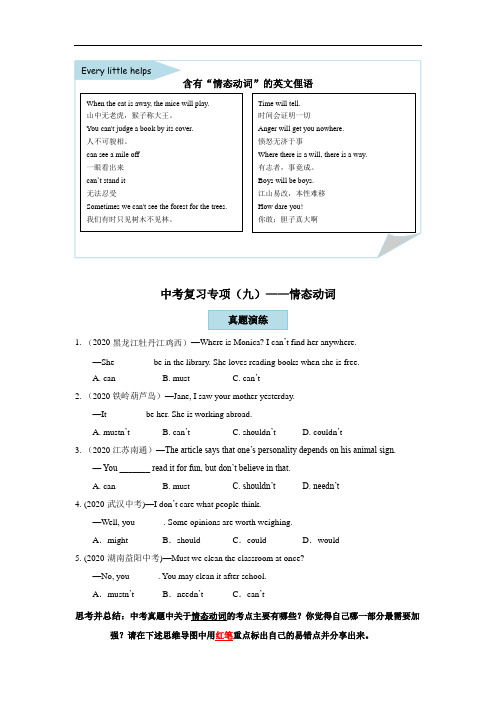
中考复习专项(九)——情态动词1.(2020黑龙江牡丹江鸡西)—Where is Monica? I can’t find her anywhere.—She ________ be in the library. She loves reading books when she is free.A. canB. mustC. can’t2.(2020铁岭葫芦岛)—Jane, I saw your mother yesterday.—It ________ be her. She is working abroad.A. mustn’tB. can’tC. shouldn’tD. couldn’t3.(2020江苏南通)—The article says that one’s personality depends on his animal sign.—You _______ read it for fun, but don’t believe in that.A. canB. mustC. shouldn’tD. needn’t4.(2020·武汉中考)—I don’t care what people think.—Well, you ______. Some opinions are worth weighing.A.might B.should C.could D.would5.(2020·湖南益阳中考)—Must we clean the classroom at once?—No, you ______. You may clean it after school.A.mustn’t B.needn’t C.can’t思考并总结:中考真题中关于情态动词的考点主要有哪些?你觉得自己哪一部分最需要加强?请在下述思维导图中用红笔重点标出自己的易错点并分享出来。
知识思维导图考点专练➢考点1:情态动词本意6.(2020·江苏连云港中考)If we don’t protect nature, some wildlife ______ die out in the future.A.need B.may C.can’t D.shouldn’t7.(2020攀枝花)—China is going to use AI to protect the Great Wall.—Great! AI is so helpful that people _____________use it in their daily life now.A. mustB. canC. shallD. have to8.(2020·湖北部分市中考)Oh! Mum, where’s my notebook? I ______ find it.A.can’t B.needn’t C.shouldn’t D.mustn’t9.(2020·江苏淮安中考)You ______ smoke here! Look at the sign. It says “No smoking”.A.needn’t B.mustn’t C.can D.may10.(2020·江苏徐州中考)Mother had a hard time getting Helen up in the morning. She called and called, but Helen ______ wake up.A.wouldn’t B.mustn’t C.needn’t D.shouldn’t11.(2020·辽宁营口中考)—Where are my keys? I’m afraid I lost them again.—Don’t worry! With the new lock, you ______ search for them any more.A.shouldn’t B.can’t C.mustn’t D.needn’t12.—Mun, can I do the homework tomorrow?—You finish it today.A.had betterB. have betterC. had better notD. had rather not13.—The room is do dirty. we clean it?—OK.A.WillB. ShallC. WouldD. Do14.There’s only one day to go. You finish your schoolwork by tomorrow.A.canB. willC. mustD. mayst year I drive. I used to take the bus.A.couldB. couldn’tC. shouldD. shouldn’t➢考点2:情态动词引导的一般疑问句16.(2020广西柳州)—Must I finish my homework now, Dad?—Yes, you ______.A. mayB. needC. must17.(2020·四川乐山中考)—______ we leave the library before 5 o’clock?—No, you needn’t. You can stay here until 5:30.A.Must B.May C.Can18.—Can we walk across the road now ?—No, we . We have to wait until the light turns green.A.couldn’tB. needn’tC. shouldn’tD. mustn’t➢考点3:情态动词表推测19.(2020·天津中考)I ______ be late, so don’t wait for me to start the meeting.A.mustn’t B.needn’t C.need D.may20.(2020·泰州中考)—In China,many students feel stressed because of too much homework. —Don’t worry. Our government has realized this problem. I’m sure there ______ be good news for them soon.A.can B.must C.should D.need21.(2020·江苏无锡中考)You ______ be able to control all the things that happen to you, but you can decide not to be reduced by them.A.need not B.may not C.must not D.should not22.(2020青海)—Lily is intelligent and hard-working, she ________ do well in the singing competition.—Sure. She was born to be a singer.A. shouldB. mightC. can’t23.(2020·辽宁抚顺本溪辽阳中考)I walked here today, so this bike ______ be mine.A.can B.mustn’t C.can’t D.must➢易混易错24.—Are you going to the cinema tonight?—I don’t know. I go or I stay at home.A.will; will B.must; must C.should; should D.might; might 25.—May I watch TV, Dad?—When your homework is finished, you .A.should B.can C.must D.need26.We pay to get into the concert. It’s free.A.can’t B.mustn’t C.might not D.don’t have to27.(2020·湖北咸宁中考)—Mum, it’s too hot. ______ I swim in the lake with my friends?—No, you______. That’s too dangerous!A.Could;mustn’t B.Need;couldn’tC.Must;needn’t D.Should;can’t28.—What it be?—It be a mail box, for it is moving. It be a car.A.can; can’t; mustB. can; can; mustC. can; mustn’t; mustD. must; mustn’t; can29.—Look, someone is coming. Guess .—Jack. He’s always on time.A.who can it beB. who he mayC. who he can beD. who it can be30.—May I use your camera this Sunday?—No, you .A.needn’t B.may not C.won’t D.mustn’t 31.—Would you like to go boating with us?—Yes, .A.I’d like B.I want C.I’d like to D.I do32.You to the meeting this afternoon if you have something important to do.A.needn’t to comeB. don’t need comeC. don’t need comingD. needn’t come33.—I take the newspaper away?—No, you mustn’t. You read it only here.A.Must; can B.May; can C.Need; must D.Must; must34.—Please don’t be late again. —Oh, sorry. I _______.A.can’tB. willC. mayD. won’t35.you continue in your efforts and achieve new and greater successes!A.MayB. CanC. HopeD. Will36.—I want to know if I smoke here.—No, you . Could you see the sign “NO SMOKING” on the wall?A.can; needn’tB. must; can’tC. shall; won’tD. can; mustn’t37.—Could I borrow your ruler?—Yes, of course you .A.willB. canC. couldD. may38.—Who is singing in the next room?—It be Lisa, but I’m not sure.A. mayB. mustC. needD. would39. I missed the last bus, so I go home on foot.A. mustB. have toC. mayD. had to40. (2020·苏州中考)—Mum, why do I have to wash hands so many times a day?—For your health, you ______ be too careful.A .can ’tB .shouldn ’tC .mustn ’tD .needn ’t根据文章大意,从方框中选择合适的词填入空中,注意选词的形式变换。
专题09情态动词中考英语考前冲刺语法图解过关(原卷版)

专题09情态动词中考英语考前冲刺语法图解过关1.—I hand in the homeworktoday?—No, you needn't.A. CanB. MustC. ShallD. Could2. —I park my car here for a while?—No,you mustn't.Do you see the sign"NO PARKING"?A. WouldB. MayC. MustD. Should3. We should keep quiet in the libraryl. We speak loudly.A. canB. mustC. needn'tD. mustn't4. —I don't care what people think.—Well, you. You're not alone in this world.A. canB. mayC. shouldD. will5. I have travelled a lot. I speak four languages.A. canB. mayC. mustD. need6. To keep children safe,we put the things like knives and medicine away in our house.A. mayB. shouldC. canD. might7. —Mum, may I go swimming now?—Yes,dear,but remember that you go with your parents.A. mayB. canC. Must D need8.—David, turn off your puter now! You play on it too long.—I see, Mum.A. couldn'tB. mustn'tC. wouldn'tD.needn’t9 —Have you got the results of the exam?—No. All we do now is wait.A. mustB. canC. mayD. could10. —Philips,you make so much noise when your little brother is sleeping?—Sorry,Mum.I'll stop right away.A. canB. mayC. mustD. could11. —Must I prepare for the trip today?—No, you prepare for it today. You can do it tomorrow.A. needB. don't needC. needn'tD. could12.—May we leave the classroom now?—No,you.You to leave until the bell rings.A. needn't; aren't allowedB. may not; are allowedC. mustn't; aren't allowedD. can't; are allowed13. —Life is being convenient with the Internet.—That's true!Almost everything be done online.A. mustB. wouldC. shouldD. can14.—Mum, I've signed for the box. What's in it?—I'm not sure. It be a present from your uncle.A. needB. mustC. mayD. will15This pair of glasses be Tony's.He's the only one who wears glasses.A. mustB. mightC. can'tD. will16. —Will Jim fly to Taiwan for a holiday?—He try.In fact,it depends on how much the journey costs.A. mayB. has toC. needD. must17. You set out alone, or you get lost in the jungle.A. needn't; mayB. mustn't; mightC. can't; needD. mustn't; must18 The little boy has just had lunch. He be hungry already.A. mustB. mustn'tC. canD. can't19 —Janet is sleeping at home.—She be. I went for a walk with her just now.A. can'tB. mustn'tC. needn'tD. won't20.)When you are travelling, bring a map because it help you.A. can'tB. mustn'tC. used toD. may21 A good friend is someone you share your pleasure and pain with.A. oughtB. needC. canD. must22. —Mum, I play football this afternoon?—Sure, but you finish your homework first.A. may; couldB. can; mustC. can; mustn'tD. may; can't23. Please don't make so much noise.I hear the speaker very well.A. needn'tB. mustn'tC. can'tD. shouldn't24. You take me to the station. My brother's taking me.A. can'tB. mustn'tC. shouldn'tD. don't have to25. —Many people play with mobile phones all day instead of reading books.—That's too bad. Everyone be a book lover. Reading is more enjoyable.A. mayB. shouldC. would26. —Mum, I visit the Modern Art Museum next Sunday?—I'm afraid you can't. All the museums in this city are closed on Monday.A. wouldB. needC. shouldD. may27.—Look at the young lady in red.Is it Mrs.Ling?—No.It be her.She is wearing a white skirt today.A. mustn'tB. needn'tC. can't28. —I still haven't found my pet cat.—I'm sorry to hear that. You be very sad.A. canB. shouldC. mustD. will29 —Jack,you fly a kite?—Yes,I can.A. canB. mayC. needD. must30. —I use your bicycle?—Of course. But please return it to me before you leave.A. MustB. NeedC. May。
初中英语中考重要情态动词用法汇总(共10个)

中考英语重要情态动词用法1.can⑴ 表示能力,一般译为“能、会”,尤其指生来具备的能力。She can swim fast, but I can’t .她会游泳,但我不会。⑵ 表示许可,常在口语中。You can use my dictionary.你可以使用我的词典。⑶ 表示推测,意为“可能”,常用于否定句和疑问句中,此时can’t译为“不可能”。Can the news be true?这个消息可能是真的吗?It can’t be our teacher.He is on a visit to the Great Wall.不可能是我们老师。他正在参观长城呢。2.could⑴ can的过去式,意为“能、会”,表示过去的能力。He could write poems when he was 10.他十岁的时候就会写诗。⑵ could在疑问句中,表示委婉请求的语气,此时could没有过去式的意思。Could you do me a favor?你可以帮我一个忙吗?—Could I use your pen?我可以使用你的钢笔吗?—Yes, you can.(注意回答)可以。3.may⑴ 表示请求、许可,比can正式,May I borrow your bike?我可以借用你的自行车吗?You may go home now.你现在可以回家了。⑵ 表示推测,谈论可能性,意为“可能,或许”,一般用于肯定句中。It may rain tomorrow .明天可能会下雨。⑶ may的过去式为 might。might 也可以表示可能性低于may(此时might没有过去式的意思)。He is away from school.He might be sick.他离开学校了。也许是病了。⑷ 表示希望、祈求、祝愿,常可译为“祝愿”。通常是用may +主+VMay you have a good time!祝你玩的愉快!May you be happy!祝你快乐!May you succeed!祝你成功!4.must⑴ must 表示主观看法,意为“必须”。You must stay here until I come back.你必须待在这里,直到我回来。Must I hand in my homework right now?我现在必须要交作业吗?⑵ 对must引导的疑问句,肯定回答为must,否定回答为needn’t或don’t have to .—Must I finish my homework?我必须完成作业吗?—No, you needn’t.不,你不必。⑶ must也可以表示有把握的推测,意为“ 一定,肯定”,用于肯定句。The light is on, so he must be at home now.灯开着,所以他现在一定在家。⑷ 其否定形式mustn’t表示“禁止,不许”。You mustn’t play with fire.你不许玩火。You mustn’t be late.你不许迟到。注意:其反意问句的构成形式:当must表示肯定的判断、推测时,其反意疑问句要用实际问句的助动词来构成。She must have seen the film before,hasn’t she?(注意反意疑问句的后半部分)她之前一定看过这部电影,难道没有吗?You must have met uncle Wang in the shop yesterday,didn’t you?(注意反意疑问句的后半部分)你昨天一定在商店见到王叔叔了,难道没有吗?5.need⑴ need表示需要,主要用于否定句和疑问句中,其否定形式为needn’t,意为“不必”。用need提问时,肯定回答为must,否定回答为needn’t或don’t have to。—Need I stay here any longer?我需要待在这里吗?—Yes, you must .是的,你必须。—No.you needn’t /don’t have to.不,你不必。(2) need还可以作实义动词,此时有人称、数和时态的变化,如果是人作主语后边多接动词不定式。I need to do it right now.我需要现在做这件事。注意:如果是物作主语,一般用need doing与need to be done,这种情况下应注意两点:① 主动形式的动名词doing具有被动的含义;② 该动名词可以改为其动词不定式的被动形式而句子的意义不变。The door needs painting.= The door needs to be painted.门需要被油漆。6.daredare意为“敢、敢于”,用法近似于need,有两种词性:⑴ dare作为情态动词,多用于否定句、疑问句或条件句中,无第三人称单数形式,只有一般现在时和一般过去时。Dare he tell them what he knows?他敢告诉他们他知道的事情吗?I daren’t ask her.Will you do it for me?我不敢问她。你可以为我问吗?⑵ dare作为实义动词,此时有人称、数及时态的变化。He doesn’t dare to break his promise.他不敢违背承诺。注意:口语中,dare的各种形式常与不带to的不定式连用。Do you dare tell her what I said?你敢告诉她我说的话吗?7.shallshall表示征求对方意见(多用于第一、三人称)Shall we go out for a walk?我们出去散步好吗?Shall the driver wait outside?司机在外面等好吗?8.should⑴ should 意为“应该”,可表示劝告、建议、义务、责任等。We should protect the environment.我们应该保护环境。⑵ Should have done 意为”本应该做某事而没做“,表示对过去动作的责备、批评。You should have finished your homework.你本应该完成作业的。(实际上没有)9.willwill表示意愿、意志、打算,可用于多种人称。I will help you if I’m free this afternoon.如果下午有空,我会帮你的。10.had betterhad better意为“最好”,没有人称的变化,后面接不带to的不定式,其否定形式为:had better not。We had better go now.你最好现在去。。
100例:初中九年级中考英语情态动词专项练习附答案
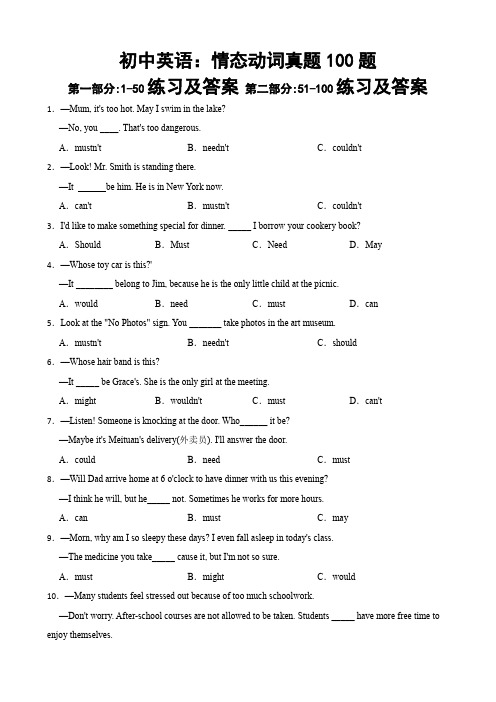
初中英语:情态动词真题100题第一部分:1-50练习及答案第二部分:51-100练习及答案1.—Mum, it's too hot. May I swim in the lake?—No, you ____. That's too dangerous.A.mustn't B.needn't C.couldn't2.—Look! Mr. Smith is standing there.—It be him. He is in New York now.A.can't B.mustn't C.couldn't3.I'd like to make something special for dinner. _____ I borrow your cookery book?A.Should B.Must C.Need D.May 4.—Whose toy car is this?'—It ________ belong to Jim, because he is the only little child at the picnic.A.would B.need C.must D.can5.Look at the "No Photos" sign. You _______ take photos in the art museum.A.mustn't B.needn't C.should6.—Whose hair band is this?—It _____ be Grace's. She is the only girl at the meeting.A.might B.wouldn't C.must D.can't7.—Listen! Someone is knocking at the door. Who______ it be?—Maybe it's Meituan's delivery(外卖员). I'll answer the door.A.could B.need C.must8.—Will Dad arrive home at 6 o'clock to have dinner with us this evening?—I think he will, but he_____ not. Sometimes he works for more hours.A.can B.must C.may9.—Morn, why am I so sleepy these days? I even fall asleep in today's class.—The medicine you take_____ cause it, but I'm not so sure.A.must B.might C.would10.—Many students feel stressed out because of too much schoolwork.—Don't worry. After-school courses are not allowed to be taken. Students _____ have more free time to enjoy themselves.A.can B.have to C.needed11.—A 14-year-old girl, Quan Hongchan, won at the 2020 Tokyo Olympics.—Nothing _____ without hard work. It took much effort for Quan to learn skills.A.can achieve B.will achieve C.will be achieved 12.—Where's Jack? His phone's out of service.—He_____ be on the ground floor. The phone can't get signal(信号) there.A.must B.can't C.might13.—Is it really necessary for me to go shopping with a mask(口罩)on?—I'm afraid you_____ in public. It's not only to protect yourself but also to protect others.A.should B.can C.must14.—_____ I have two tickets for the Chinese Farmers' Painting Exhibition?—Sorry. The tickets have been sold out.A.Must B.Need C.May15.—Who is playing the piano in the music room? Is it Mary?—No, it ___________be her. She has ___________to Beijing on business.A.couldn't; been B.can't; goneC.can't; been D.mustn't; gone16.—Whose physics book is this?—It _____be Helen's because her name is on it.A.mustn't B.must C.might D.can't 17.—David, do you know Su Yiming, a snowboarder from China?—Sure. He won the first place in the men's Big Air Event. He_____________ be hard-working.A.needn't B.can't C.should D.must 18.The boy ________ be Tom. I saw him reading in the library just now.A.shouldn't B.can't C.needn't19.— Mike, I can't stop playing computer games.— For your eyes, my dear friend, I'm afraid you____.A.could B.may C.would D.have to 20.—I can't find my dictionary. ________ I use yours?—Sure, here you are.A.Need B.May C.Must D.Should21.—_________ I take photos here?—Sorry, you can't. It's not allowed in the museum.A.Must B.Need C.Can D.Will22.To achieve our dream, we ________ rest on what we have done.A.may not B.should not C.need not D.could not23.—I don't care what Kate thinks.—Well, you _______. Her suggestions are of some value.A.would B.should C.might D.could 24.—Whose English book is this?—It _______ be Lily's, but I'm not sure.A.might B.can't C.must25.You ________ drive without a license!A.can B.must C.mustn't D.may26.When our parents become too old to take care of themselves one day, they __________ be looked after well by us.A.should B.shouldn't C.may D.may not 27.—Excuse me. _______ I sit here?—You'd better not. It's the man's seat.A.Must B.Need C.Could D.Should28.We should learn some basic life skills since we ________ depend on ourselves some day.A.can B.can't C.must D.mustn't 29.—Can we play games here?—Better not. If you ________, please go to the open space there.A.must B.can C.may D.will30.—The paper cutting is pretty lively, who made it?—It ________ be Amy. None of us except her is able to do it.A.would B.need C.must D.can31.— ________ you tell us a story in English?—I think I can do it. Let me try.A.Need B.Can C.Should D.Must32.—Look! Mark is reading a book in the library.—It ______ be him. He is in the classroom.A.can't B.wouldn't C.needn't33.—Listen! I think it ________ be Mrs. Li singing in the next room.— It ________ be her. I know she has already left for New York.A.may, must B.must, can't C.must, mustn't 34.—Whose is this toy truck?—It _________ belong to Dick. He was the only little kid at the picnic.A.can't B.must C.could D.need 35.—What kind of music do you like?—I like music that I ______ dance to.A.can B.must C.should D.need 36.—Alex, come down to play football.—I can't. Mom said I __________ clean my bedroom before doing anything else.A.had to B.will C.used to D.can37.The book ______ be Mary's. We can see her name on it.A.need B.must C.can't D.needn't 38.—To make our school more beautiful, we _____throw the rubbish on the ground.—Everyone should play an important part in doing it.A.needn't B.mustn't C.may not39.Jim can swim, but I________.A.don't B.can't C.am not40.—Wow! Here is an offer of Tsinghua University! _______it be Bob's?—It must be Bob's, he is the most excellent student in our school.A.May B.Can C.Must D.Shall41.You ________ pay too much attention to your reading skill as it's very important.A.shouldn't B.needn't C.mustn't D.can't 42.—Have you decided how to spend this weekend with your family, Lingling?—Not yet. We ____ go camping along Nanxi River to enjoy beautiful sights.A.must B.should C.need D.may43.— No one knows what it will be like tomorrow because there are many possibilities such diseases, disasters(灾难) and so on.— Yeah, but sometimes the facts show that humans stronger than the forces of nature.A.can't be B.can be C.mustn't be 44.The girl in the classroom ____ be Maria. She called me from the library just now.A.mustn't B.may not C.can't D.needn't 45.—Could you tell me how to renew the library books?一With pleasure. You________ come to our desk every time. It's easier to renew them online.A.can't B.mustn't C.shouldn't D.needn't 46.—Mom, can I watch TV this evening?—You ________ finish your homework first.A.can B.may C.must D.shall 47.— Whose toy car is this?—It be Sally's. She's the only little kid at the dinner party.A.should B.must C.might D.can't 48.—A country has dreams. We teenagers also have dreams.—With dreams and hard work, anything amazing can be created.A.should B.may C.must D.can 49.—Is that Li Ming over there?—It___ be him. He is working as a volunteer in Henan.A.can't B.mustn't C.must 50.—Some Chinese scientist are now doing research on sea rice.—If farmers__________ start planting rice in salty water, Chinese food supply will surely rise.A.can B.can't C.must D.mustn't答案解析部分1.A2.A3.D4.C5.A6.C7.A8.C9.B10.A11.C12.A13.C14.C15.B16.B17.D18.B19.D20.B21.C22.B23.B24.A25.C 26.A 27.C 28.C 29.A 30.C 31.B 32.A 33.B 34.B 35.A 36.A 37.B 38.B 39.B 40.C 41.D 42.D 43.A 44.C 45.D 46.C 47.B 48.A 49.A 50.A第二部分:51-100练习及答案1.—Someone is knocking at the door. Maybe Peter has come.—It be Peter because he has gone to New Zealand.A.can't B.may C.mustn't D.shall 2.—Mr. Wang, must I come again to clean the classroom on Sunday?—No, you . I have asked Kate to do it.A.can't B.mustn't C.needn't D.shouldn't 3.—________I return the book today, Mr. Lin?—No, you ________. You can keep it for two days.A.May; mustn't B.Must; mustn'tC.Must; needn't D.Can; shouldn't4.—Do you have any plans for the coming summer holidays?—I take part in some volunteering activities. I haven't decided.A.need B.may C.must D.could 5.—Must I go to Nanyang Square this afternoon to see him?— No, you . You can wait for his call.A.mustn't B.can't C.needn't D.shouldn't 6.—Jack must be in his office, I think.—No, he be in the office. He flew to Canada this morning.A.needn't B.shouldn't C.can't D.mustn't 7.— Is it Jay who didn't hand in the history homework this morning?— No, it ________ be Jay. History is his favourite subject.A.can't B.needn't C.shouldn't D.mustn't 8.—Tom, we play King of Glory(王者荣耀) together this weekend?—I'm afraid not. There is too much homework to do. We finish it on time.A.shall; can't B.may; must C.shall; should D.can; will 9.—Must I go to medical school and be a doctor like you, Dad?—No, you ________, son. You're free to make your own decision.A.can't B.shouldn't C.needn't D.mustn't 10.—Life is becoming convenient with the Internet.—That's true! Almost everything ______ be done online.11.—Dad, I've signed for the box. What's in it?—I'm not sure. It _____ be a present from your uncle.A.need B.must C.may D.will 12.—Sixty dollars for such a T-shirt! You be joking!—I'm serious. It's made of silk from Hangzhou.A.must B.need C.will D.can 13.— Mum, may I go swimming now?—Yes, dear, but remember that you ___________go with your dad.A.may B.can C.must D.should 14.—Could I invite my friends to our party on Sunday, mom?—Of course you _____. That sounds great.A.may B.can C.could D.must 15.— Hi, Tom! Is this new red bike Tim's? He told me he bought a new one.— It _______ be Tim's. He never buys things in red.A.can B.must C.can't D.mustn't 16.I love the weekend because I _______ get up early to go to school.A.can't B.mustn't C.needn't D.shouldn't 17.—Look! It _____ be John on the playground.—It_____ be him. I saw him in the classroom just now.A.may, mustn't B.must, can't C.can can't D.mustn't, can 18.—Mum, must I finish my homework today?—________. You may do it tomorrow morning.A.No, you mustn't B.No, you needn't C.Yes, you must 19.—I missed last night's Everlasting Classics(《经典咏流传》)!—You care. You can watch it online later.A.mustn't B.can't C.may not D.needn't 20.He _________ work on the farm every day. I'm sure about that because his skin is very black.A.can't B.may C.must D.couldn't 21.— Mom, I eat the sandwiches now ?— No. You must set the table first.22.— Mom, must I wash the clothes now?— No, you . You wash them in the afternoon.A.mustn't; must B.needn't; must C.mustn't; can D.needn't; can 23.—Whose is the notebook?—It ________ be Mary's. Look at her name on the cover.A.can B.may C.must D.need24.—Why don't you stay a little longer?—Sorry, I . I have to meet my uncle at the airport.A.must B.should C.needn't D.can't 25.Parents encourage their children to take part in volunteer work. It will have a good influence on themA.should B.mustn't C.might D.can't 26.—Listen! Is Millie playing the violin in the music room?—No. It be her. She has gone to the teachers' office.A.should B.must C.needn't D.can't27.You be tired after walking for such a long time. Sit down and have a rest.A.can B.can't C.mustn't D.must28.—Look! Is the man wearing a white shirt your father?—No, it ________be him. He is picking up my sister at the airport.A.may B.must C.can't D.mustn't29.—________ you leave now? You only arrived here an hour ago.—Sorry, but so much homework is waiting for me.A.May B.Must C.Can D.Might30.The magazines on the bookshelf are free for students. You keep one if you like.A.need B.must C.can D.should 31.Children under 12 years of age in that country go together with their parents when in a public library.A.must B.may C.can D.need32.—Who it be that is knocking at the door?—It be father, but I'm not sure.A.call; must B.can; may C.must; can D.may; must 33.—Lucy doesn't mind lending you her bike.—She , I've already borrowed one.A.can't B.mustn't C.needn't D.shouldn't 34.—Is there a flight to Paris this evening?—There be. I'll phone the airport and find it out.A.must B.would C.might D.can 35.—Must I stay here with you?—No, you . You may go home, but you go to the net bar(网吧).A.mustn't; needn't B.needn't; mustn'tC.must; need D.need; must36.—It's so late. Our son be back!—Don't worry. I dare say he have some extra work to do.A.can; must B.will; might C.should; must D.must; may 37.Marie witnessed everything but it is amazing that she have say nothing about the murder.A.can B.may C.must D.should 38.—Listen! Someone is singing in the next room. Who it be? Is it Linda?—No, it be her. She is at school now.A.may, can't B.must, mustn't C.will, may not D.may, won't 39.I'm feeling much better now so you ______ call the doctor.A.couldn't B.wouldn't C.can't D.needn't 40.—I'm a little tired. Let's go shopping by taxi.—We ______take a taxi. It's not far from here.A.mustn't B.couldn't C.needn't D.can't41.If you study harder, you will______ go to college.A.be able B.can C.be able to D.able to 42.When traffic lights are red, we stop and wait.A.should B.must C.need D.can 43.—Joe, what are you looking for?—My model plane. I ________ find it because it is a gift from my dearest grandpa.A.would B.must C.could D.can44.—What are you doing this weekend?—I'm not sure, but I ________go to Daming Lake.A.might B.must C.should D.need 45.— ____ I play computer games now, Mom?— No. You ______. You have to finish your homework first.A.May; mustn't B.Can; couldn't C.May; could D.Can; may not 46.— Someone is knocking at the door. Is it Ann? I've been waiting for her so long.—I'm sorry, it _____ be her. I saw her staying at school half an hour ago.A.may not B.shouldn't C.can't D.mustn't 47.— Excuse me, could you help me check if _________ tomorrow?— Ok. If you _____.A.the game will take place; mustB.the game is going to take place; needC.the game takes place; shouldD.the game is taking place; must48.—Marcus, could I have a look at your new mobile phone?—Of course you . Here you are.A.may B.could C.must D.can 49.—Can't you stay a little longer?—It's getting late I go now. My daughter is home alone。
中考英语情态动词考点总结与归纳
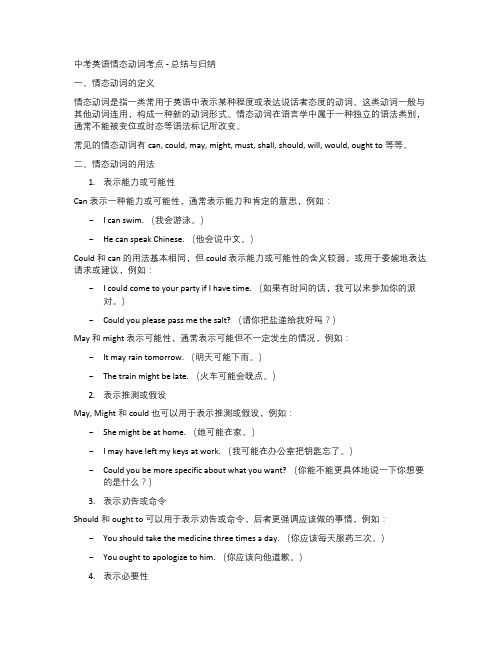
中考英语情态动词考点 - 总结与归纳一、情态动词的定义情态动词是指一类常用于英语中表示某种程度或表达说话者态度的动词。
这类动词一般与其他动词连用,构成一种新的动词形式。
情态动词在语言学中属于一种独立的语法类别,通常不能被变位或时态等语法标记所改变。
常见的情态动词有 can, could, may, might, must, shall, should, will, would, ought to 等等。
二、情态动词的用法1.表示能力或可能性Can 表示一种能力或可能性,通常表示能力和肯定的意思,例如:-I can swim. (我会游泳。
)-He can speak Chinese. (他会说中文。
)Could 和 can 的用法基本相同,但 could 表示能力或可能性的含义较弱,或用于委婉地表达请求或建议,例如:-I could come to your party if I have time. (如果有时间的话,我可以来参加你的派对。
)-Could you please pass me the salt? (请你把盐递给我好吗?)May 和 might 表示可能性,通常表示可能但不一定发生的情况,例如:-It may rain tomorrow. (明天可能下雨。
)-The train might be late. (火车可能会晚点。
)2.表示推测或假设May, Might 和 could 也可以用于表示推测或假设,例如:-She might be at home. (她可能在家。
)-I may have left my keys at work. (我可能在办公室把钥匙忘了。
)-Could you be more specific about what you want? (你能不能更具体地说一下你想要的是什么?)3.表示劝告或命令Should 和 ought to 可以用于表示劝告或命令,后者更强调应该做的事情,例如:-You should take the medicine three times a day. (你应该每天服药三次。
中考英语情态动词总结

中考英语情态动词总结情态动词是一类特殊的动词,表达了说话人的态度、意愿、能力、推测等情态。
常见的情态动词有can, could, may, might, must, shall, should, will, would, ought to等。
下面是关于这些情态动词的总结:1. can: 表示能力、许可。
常用于肯定句和疑问句中,一般不能用于否定句。
例如:"I can swim."(我会游泳。
)"Can you help me?"(你能帮我吗?)2. could: 表示过去的能力、许可,也可以用于请求或建议。
例如:"When I was young, I could run very fast."(我小时候跑得很快。
)"Could you please pass me the salt?"(你能帮我递一下盐吗?)4. might: 表示较小的可能性,常用于虚拟语气句中。
例如:"If it doesn't rain, we might go for a picnic."(如果不下雨,我们可能去野餐。
)5. must: 表示必须、推测的肯定。
例如:"You must finish your homework before you go out."(你必须在出去之前完成作业。
)"It's already 9 o'clock. He must be at home."(已经9点了,他一定在家。
)6. shall: 表示将来的意愿,用于第一人称(I, we)的疑问句中。
例如:"Shall we go to the park tomorrow?"(明天我们去公园吧?)7. should: 表示应该,常用于建议、请求中。
例如:"You should take a break."(你应该休息一下。
【中考英语考点详解+专项训练】专题9 情态动词 (原卷版)

情态动词是初中英语里的一个重要的语法项目,也是全国各省市中考试题的考查热点。
在备战中考时,考生要牢记情态动词的结构和意义以及其表示推测时的用法,多做练习,在实践中加以区分。
中考考查重点:1. 情态动词的意义;2. 情态动词的基本句型;3. 情态动词的基本用法。
情态动词的用法情态动词用法例句can/could 表示能力,意为"能,会"I can read this sentence in English. 我能用英语读这句话。
表示许可时,意为"可以,能够",相当于mayShe said that I could use her computer. 她说我可以使用她的电脑。
用于推测,表示可能性,意为"可能",could比can更加不肯定,多用于否定或疑问句The man can’t be our teacher — he has gone to Beijing.那个男人不可能是我们的老师,他去北京了。
There is someone outside — who can it be? 有人在外面,可能是谁呢?【知识拓展】1. can的一般疑问句,肯定回答用Yes, ...can;否定回答用No, ...can’t。
—Can you play the piano? 你会弹钢琴吗?—Yes, I can. 是的,我会。
/No, I can’t 不,我不会。
2. can,could和be able to的区别:can只有现在式和过去式,而be able to可以用于各种时态;can( could)表示能力时,可用be able to代替。
I can(am able to) afford the car. 我能买得起这辆小汽车。
She has been able to come to school. 她已经能去学校了I could(=was able to) drive a car before I left school. 毕业前我就会开车。
初三英语情态动词试题
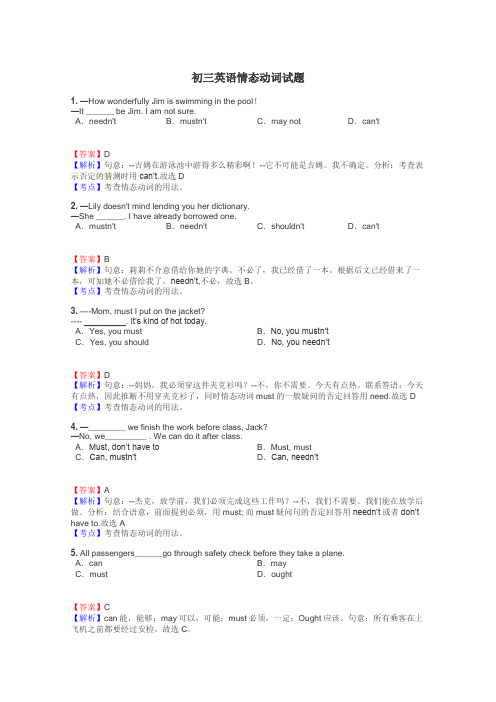
初三英语情态动词试题1.—How wonderfully Jim is swimming in the pool!—It ______ be Jim. I am not sure.A.needn't B.mustn't C.may not D.can't【答案】D【解析】句意:--吉姆在游泳池中游得多么精彩啊!--它不可能是吉姆。
我不确定。
分析:考查表示否定的猜测时用can’t.故选D【考点】考查情态动词的用法。
2.—Lily doesn't mind lending you her dictionary.—She ______. I have already borrowed one.A.mustn't B.needn't C.shouldn't D.can't【答案】B【解析】句意:莉莉不介意借给你她的字典。
不必了,我已经借了一本。
根据后文已经借来了一本,可知她不必借给我了。
needn’t,不必,故选B。
【考点】考查情态动词的用法。
3. ----Mom, must I put on the jacket?---- _________. It’s kind of hot today.A.Yes, you must B.No, you mustn’tC.Yes, you should D.No, you needn’t【答案】D【解析】句意:--妈妈,我必须穿这件夹克衫吗?--不,你不需要。
今天有点热。
联系答语:今天有点热,因此推断不用穿夹克衫了,同时情态动词must的一般疑问的否定回答用need.故选 D 【考点】考查情态动词的用法。
4.—________ we finish the work before class, Jack?—No, we_________ . We can do it after class.A.Must, don’t have to B.Must, mustC.Can, mustn’t D.Can, needn’t【答案】A【解析】句意:--杰克,放学前,我们必须完成这些工作吗?--不,我们不需要。
【中考英语 考题研究】专题09 情态动词(解析版)

专题09 情态动词1.(2022·江苏淮安·统考中考真题)—Miss Li. I don’t want to say sorry to Daniel.—I’m afraid you ________. After all, you broke his glasses.A.may B.have to C.mustn’t D.needn’t【答案】B【详解】句意:——李小姐。
我不想向丹尼尔道歉。
——恐怕你必须这么做。
毕竟,你打破碎了他的眼镜。
考查情态动词。
may可能;have to必须;mustn’t禁止;needn’t不需要。
根据“After all, you broke his glasses.”可知对方必须要向丹尼尔道歉,故选B。
2.(2022·江苏盐城·统考中考真题)Safety comes first. Everyone on the coach ________ wear the seat belt.A.can B.can’t C.must D.mustn`t【答案】C【详解】句意:安全第一。
车上的每个人都必须系好安全带。
考查情态动词。
can能,可以;can’t不能,不会;must必须;mustn’t禁止,不能。
根据“Safety comes first”和“wear the seat belt”可知,安全最重要,故必须系好安全带。
故选C。
3.(2022·江苏南通·统考中考真题)In the library you ________ draw or write in the books, or you will be fined.A.mustn’t B.needn’t C.wouldn’t D.couldn’t【答案】A【详解】句意:在图书馆你不能在书上画画或写字,否则你会被罚款。
考查动词辨析。
mustn’t禁止;needn’t不必;wouldn’t不会;couldn’t不可能。
2023年江苏中考英语核心语法精讲精练专题09 情态动词-含详解
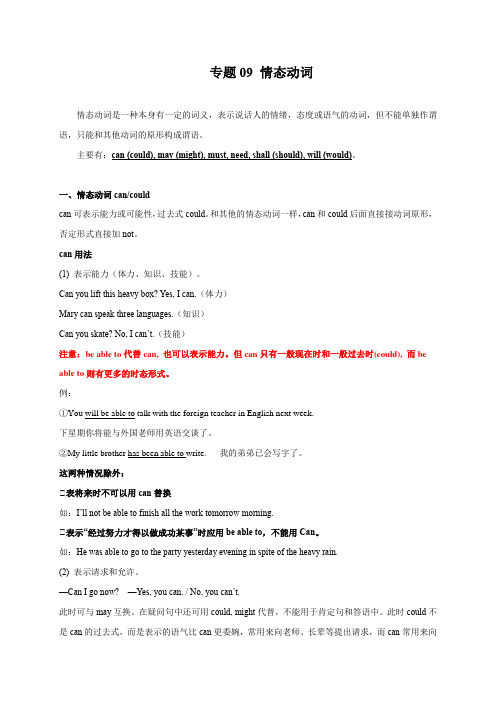
专题09 情态动词情态动词是一种本身有一定的词义,表示说话人的情绪,态度或语气的动词,但不能单独作谓语,只能和其他动词的原形构成谓语。
主要有:can (could), may (might), must, need, shall (should), will (would)。
一、情态动词can/couldcan可表示能力或可能性,过去式could。
和其他的情态动词一样,can和could后面直接接动词原形,否定形式直接加not。
can用法(1) 表示能力(体力、知识、技能)。
Can you lift this heavy box? Yes, I can.(体力)Mary can speak three languages.(知识)Can you skate? No, I can’t.(技能)注意:be able to代替can, 也可以表示能力。
但can只有一般现在时和一般过去时(could), 而be able to则有更多的时态形式。
例:①You will be able to talk with the foreign teacher in English next week.下星期你将能与外国老师用英语交谈了。
②My little brother has been able to write. 我的弟弟已会写字了。
这两种情况除外:①表将来时不可以用can替换如:I’ll not be able to finish all the work tomorrow morning.①表示“经过努力才得以做成功某事”时应用be able to,不能用Can。
如:He was able to go to the party yesterday evening in spite of the heavy rain.(2) 表示请求和允许。
—Can I go now? —Yes, you can. / No, you can’t.此时可与may互换。
2024年中考英语真题专项汇编(9)情态动词(含答案)
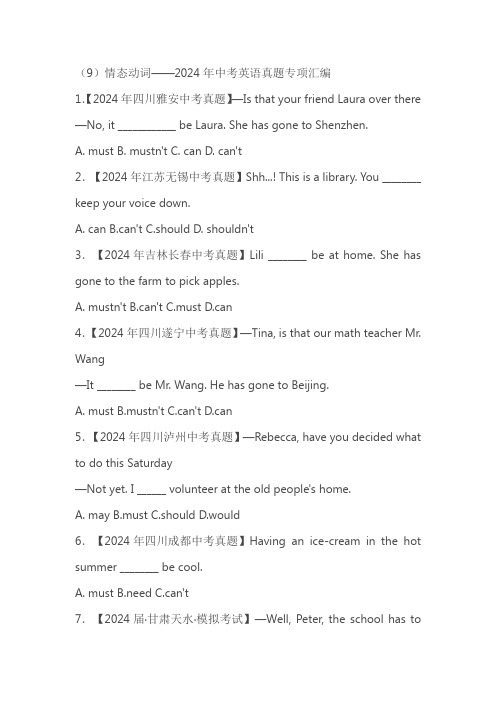
(9)情态动词——2024年中考英语真题专项汇编1.【2024年四川雅安中考真题】—Is that your friend Laura over there —No, it ____________ be Laura. She has gone to Shenzhen.A. mustB. mustn'tC. canD. can't2.【2024年江苏无锡中考真题】Shh...! This is a library. You ________ keep your voice down.A. canB.can'tC.shouldD. shouldn't3.【2024年吉林长春中考真题】Lili ________ be at home. She has gone to the farm to pick apples.A. mustn'tB.can'tC.mustD.can4.【2024年四川遂宁中考真题】—Tina, is that our math teacher Mr. Wang—It ________ be Mr. Wang. He has gone to Beijing.A. mustB.mustn'tC.can'tD.can5.【2024年四川泸州中考真题】—Rebecca, have you decided what to do this Saturday—Not yet. I ______ volunteer at the old people's home.A. mayB.mustC.shouldD.would6.【2024年四川成都中考真题】Having an ice-cream in the hot summer ________ be cool.A. mustB.needC.can't7.【2024届·甘肃天水·模拟考试】—Well, Peter, the school has tohave rules. You can't take the test because you are late.—I know, but it's not fair. They ____ let me take the test later.A. shouldB. couldn'tC. mightD. wouldn't8.【2024届·河北唐山·二模】—________ I add some sugar to it —Of course. It's up to your taste.A. MustB. ShouldC. WillD. Can9.【2024届·江苏南通·一模】—Do you know the saying “ When I walk along with two others, they ________ serve me as my teachers.”— Yes. It tells us we can learn from the people around us.A. mayB. mustC. shouldD. need10.【2024届·吉林长春·二模联考】—Sam, ________ I join you in the community service—Of course you can.A. needB. mustC. shouldD. can11.【2024届·广西钦州·一模】—Betty is absent. What's the matter with her—I'm not sure. She ________ be ill.A. mustB. mayC. has to12.【2024届·吉林吉林·二模】—The paper cutting is pretty lively. Who made it—It _________ be Mary. None of us is able to do it except her.A. canB. mustC. might13.【2024届·山东菏泽·二模】Students ______ be allowed to bring their cellphones to the classroom. What's your ideaA. shouldn'tB. couldn'tC. needn't14.【2024届·山东菏泽·二模】Jim lost this competition. He _______ be sad now. Let's go and cheer him up.A. mustB. has toC. can't15.【2024届·海南海口·一模】—I hear you have a home robot. —Yes, it's amazing. It ______ do all my housework.A. canB. mustC. should参考答案1.答案:D2.答案:C解析:句意:嘘……!这里是图书馆。
情态动词中考英语

中考英语语法之情态动词一.情态动词的用法1. can 用法1)表示能力,与be able to同义,但can只用于现在时和过去时,be able to 可用于各种时态。
Two eyes can see more than one.注:Can you … ? Yes, I can / No,I can’t.2).表示允许、请求用could比can 语气更加委婉客气,常用于could I /you …..?句型中,若表示同意时,用can回答而不用could .Could I borrow t he book ? No, you can’t .3)。
表示推测“可能”常用于否定句或疑问句中。
(can’t表示一定不是)It can’t be true . Can it be true ?2. may 用法1)表允许,请求= can表示许可或征求对方的许可,常于第一人称连用。
注:May I ….? Yes ,you mayNo, you can’t / mustn’t .在回答以may引起的问句时,多避免用这个词,而用其它方式,如Yes, please. / Certainly.2)表推测,可能、也许。
常用于肯定句中。
Maybe he knows the news .=He _maybe_ _knows_ the news.Maybe he is angry.= He _may_ _be_ angry.3. must1)表示义务。
意为“必须”(主观意志)。
We must do everything step by step.注:Must I ….? Yes, you must / No,you needn’t(don’t have to ).--Must we hand in our exercise—books now?--No, you needn’t. / No, you don’t have to.2)mustn’t 表禁止、不允许。
中考英语--情态动词should、had better和may的用法
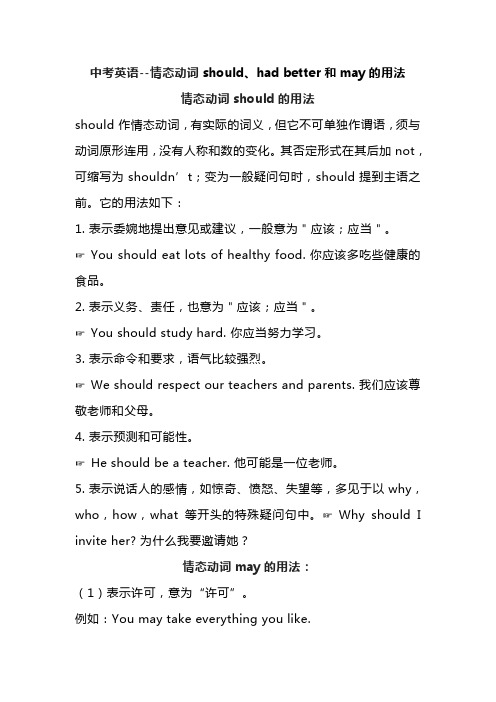
中考英语--情态动词should、had better和may的用法情态动词should的用法should 作情态动词,有实际的词义,但它不可单独作谓语,须与动词原形连用,没有人称和数的变化。
其否定形式在其后加not,可缩写为shouldn’t;变为一般疑问句时,should 提到主语之前。
它的用法如下:1. 表示委婉地提出意见或建议,一般意为"应该;应当"。
☞ You should eat lots of healthy food. 你应该多吃些健康的食品。
2. 表示义务、责任,也意为"应该;应当"。
☞ You should study hard. 你应当努力学习。
3. 表示命令和要求,语气比较强烈。
☞ We should respect our teachers and parents. 我们应该尊敬老师和父母。
4. 表示预测和可能性。
☞ He should be a teacher. 他可能是一位老师。
5. 表示说话人的感情,如惊奇、愤怒、失望等,多见于以why,who,how,what等开头的特殊疑问句中。
☞ Why should I invite her? 为什么我要邀请她?情态动词may的用法:(1)表示许可,意为“许可”。
例如:You may take everything you like.(2)表示推测,通常用于肯定句和否定句中,意为“可能”。
例如:He may be very busy now.注意:can和may都不是可能性,can通常用于否定句和疑问句中,而may通常用于肯定句和否定句中。
虽然两者均可用于否定句中,但其意思不同:can't意为“不可能”,may not意为“可能不”。
另外,can和may均可表示请求允许,但can为一般用词,而may为正式用词。
had better的用法其意为“最好”、“应该”,后接动词原形,与情态动词should 用法相似,其中的had通常缩略为 'd。
初三中考英语情态动词附答案附答案含答案
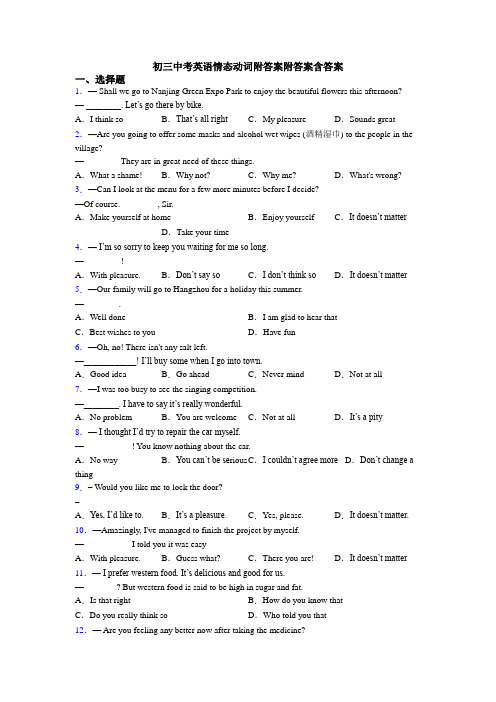
初三中考英语情态动词附答案附答案含答案一、选择题1.— Shall we go to Nanjing Green Expo Park to enjoy the beautiful flowers this afternoon?—________. Let’s go there by bike.A.I think so B.That’s all right C.My pleasure D.Sounds great 2.—Are you going to offer some masks and alcohol wet wipes (酒精湿巾) to the people in the village?—________ They are in great need of these things.A.What a shame! B.Why not? C.Why me? D.What's wrong? 3.—Can I look at the menu for a few more minutes before I decide?—Of course. ________, Sir.A.Make yourself at home B.Enjoy yourself C.It doesn’t matterD.Take your time4.—I’m so sorry to keep you waiting for me so long.— ________!A.With pleasure. B.Don’t say so C.I don’t think so D.It doesn’t matter 5.—Our family will go to Hangzhou for a holiday this summer.—________.A.Well done B.I am glad to hear thatC.Best wishes to you D.Have fun6.—Oh, no! There isn't any salt left.—____________! I’ll buy some when I go into town.A.Good idea B.Go ahead C.Never mind D.Not at all7.—I was too busy to see the singing competition.—________. I have to say it’s really wonderful.A.No problem B.You are welcome C.Not at all D.It’s a pity8.—I thought I’d try to repair the car myself.— __________ ! You know nothing about the car.A.No way B.You can’t be se rious C.I couldn’t agree more D.Don’t change a thing9.– Would you like me to lock the door?– _______A.Yes, I’d like to.B.It’s a pleasure.C.Yes, please. D.It doesn’t matter. 10.—Amazingly, I've managed to finish the project by myself.—___________I told you it was easyA.With pleasure. B.Guess what? C.There you are! D.It doesn’t matter 11.—I prefer western food. It’s delicious and good for us.—_______ ? But western food is said to be high in sugar and fat.A.Is that right B.How do you know thatC.Do you really think so D.Who told you that12.— Are you feeling any better now after taking the medicine?—________. I’m feeling even worse.A.You got it B.Never mind C.Sorry to hear that D.Quite the opposite 13.-Do you mind telling me how to use this function? - . It’s easy. Just double-click on the “Pencil” icon.A.No, not at all B.Of course, I doC.Yes, I do D.Yes, I don’t14.— The dress I got is not the same color as that is shown online.—________? But if so, I promise we will send you another one.A.How come B.Who knows C.What for D.Why worry 15.—I have got a new job as a presenter in the Wenzhou Radio Station!—________.A.Come on B.Good idea C.Congratulations D.All right 16.—TV says there will be a heavy rain tomorrow.—________. I planned to go climbing with my friend.A.Bad luck B.I hope so C.Good idea D.I don’t mind 17.—Why not take your son to watch the new film A Little Red Flower?—__________.A.Good idea B.No problem C.Good luck D.No way 18.—Do you like cartoons or scary movies?—_______. They can cheer me up.A.Yes, I do B.No, I don't C.Cartoons D.Scary movies 19.—I’m sorry I didn’t make it to your birthday party last night.— ________ I know you are busy recently.A.Why not? B.Don’t mention it.C.No way. D.That’s all right. 20.—Excuse me, can you give me some water? The cup is empty.—________A.Go ahead. B.My pleasure C.At your service D.You’d better not. 21.—Susan, will you please go and empty that drawer?— _________ ?A.What for B.What is it C.How is it D.How come 22.—I’m going hiking this afternoon. Would you like to go with me?—______, but I must finish my homework first.A.Sorry, I don’t B.That’s right C.I’d love to D.Not at all 23.—Jim seems to be in low spirits. ________?—No one liked his plan. All his efforts were useless.A.Guess what B.What about him C.So what D.What happened 24.—Anna, can you come to my party tomorrow night?—_________, but I have to stay at home because of the flu.A.I’d love to B.Sounds good C.That’s OK D.Why not 25.—Would you like a small or a large bowl of noodles? —_______. I’m very hungry.A.A small bowl B.A large bowl C.Yes, please D.No, thanks26.—________!—Yes. It sounds gentle and relaxing.A.How good the vegetable soup is B.How exciting the storybook isC.What nice music Ann is playing D.What a beautiful flower Jim keeps 27.—Can you tell me how to get to the park?—________—Thank you all the same.A.Show me the map, please.B.Certainly. It’s opposite the museum.C.Sorry, I don’t know. I’m a stranger here.D.Sure. Turn right and go along Rock Road.28.—All of Mark Twain’s novels are popular.— ________. Especially The Adventures of Tom Sawyer.A.I can’t agree more B.That’s not the case C.That’s not the point D.Don’t mention it 29.—Time is up. I have to go now.—________ ! We don’t have more time to talk.A.That’s cool B.That’s the answer C.That’s a pity D.That’s good news 30.—Would you mind if I open the window?—_______.We need fresh air.A.Not at all B.Yes, of course C.You’d better not D.That’s all right 31.—Only those who have a lot in common can get along well.—________. Opposites sometimes attract.A.I think so B.I don’t think so C.I don’t care D.I hope so 32.— Why will you take part in the charity walk? You are not good at running at all.— ________. I run to show that I can help others.A.Not exactly B.That’s not the point C.I can’t agree more D.It sounds like a pity 33.—How do you like coffee, Minnie?—It tastes very terrible. ________.A.I have no idea B.I don’t mind it C.I really can’t stand it D.I can’t afford it 34.— Mr. Smith, I won the first prize in the competition.—______ I think you’ll do better and better.A.Congratulations! B.Good idea! C.That’s all right!D.What a shame! 35.—He is too short to be a successful basketball player.—________ Every dog has its day.A.I think so. B.I t’s hard to say.C.That’s right.D.You’d better not. 36.— May I have a look at the newspaper China Daily?— Certainly. ________A.Thank you. B.It’s a pity.C.Here you are. D.I’d like to. 37.—Another Friday! Let’s go to see the play tonight.—________ I will book the tickets online.A.My pleasure. B.That’s right.C.Why not? D.Never mind.38.— Do you think Steve will pass the exam this time?— ________! He spends most of his time playing games on the phone.A.Promise B.No way C.Well done D.No problem 39.—W hy don’t you join in a club to practise speaking English?—________.A.That’s a good idea B.Never mind C.Yes, please D.Thank you 40.—How about putting some pictures into the report?—________ A picture is worth a thousand words.A.I don’t think so.B.Why not?C.Thank you. D.Don’t mention it.41.—How about buying that coat?—________. It’s too expensive. I can’t afford it.A.That sounds good B.No way C.Good idea D.What a pity 42.—I’ll be away on a business trip. Would you mind looking after my cat?—Not at all. ________.A.It’s my pleasure B.I’d rather not.C.I’d like it.D.With pleasure. 43.—I’ll have a chemistry exam tomorrow.—________!A.Well done B.Congratulations C.You’re welcome D.Good luck 44.—Summer camping gives children the chance to live away from home.—________. It is always good to help children grow up.A.That’s true.B.Come this way. C.Let me have a look. D.I don’t think we agree.45.—I visited the Purple Mountain Observatory by myself last Saturday.—________ Why didn’t you tell me earlie r?A.You did? B.I hope not. C.Have a good time. D.I can’t believe it. 46.—Do you think you could finish this project without help?—________. This is not the first time for me.A.Take care B.Don’t worry C.Not exactly D.Hurry up 47.—Our school football team has won the first prize in the match!—________A.Have a good time. B.Nice work. C.Never mind. D.Good luck. 48.—Mum, Joe has broken a cup!—________. Accidents always happen.A.Pretty good B.Of course C.It doesn’t matter D.That depends 49.— The movie Lost in Russia sends a message about the importance of family.— ________. It reminds me of my parents.A.I hope so B.That’s all right C.You bet D.I don’t think so 50.— Mike, are you ready for the coming final exam?— ________. I have prepared it for weeks.A.You bet B.No deal C.Bad luck D.Have fun【参考答案】***试卷处理标记,请不要删除一、选择题1.D【详解】句意:——今天下午我们去南京绿博览园赏花好吗?——听起来不错。
初中九年级中考英语情态动词专项练习与答案
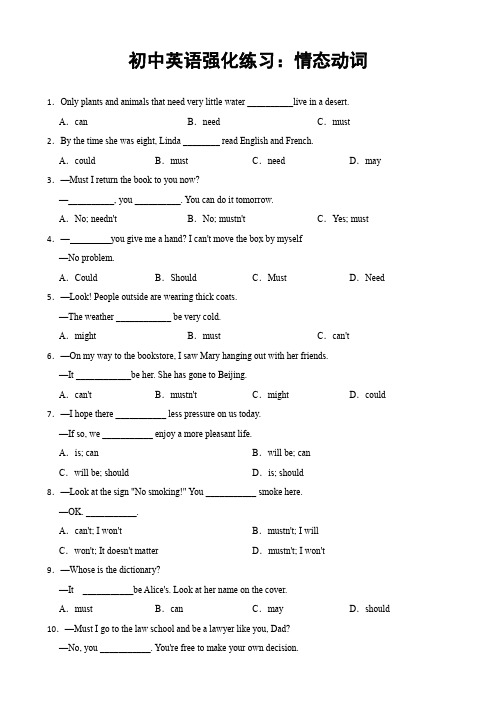
初中英语强化练习:情态动词1.Only plants and animals that need very little water __________live in a desert.A.can B.need C.must2.By the time she was eight, Linda ________ read English and French.A.could B.must C.need D.may 3.—Must I return the book to you now?—__________, you __________. You can do it tomorrow.A.No; needn't B.No; mustn't C.Yes; must 4.— you give me a hand? I can't move the box by myself—No problem.A.Could B.Should C.Must D.Need 5.—Look! People outside are wearing thick coats.—The weather ____________ be very cold.A.might B.must C.can't 6.—On my way to the bookstore, I saw Mary hanging out with her friends.—It ____________be her. She has gone to Beijing.A.can't B.mustn't C.might D.could 7.—I hope there ___________ less pressure on us today.—If so, we ___________ enjoy a more pleasant life.A.is; can B.will be; canC.will be; should D.is; should8.—Look at the sign "No smoking!" You ___________ smoke here.—OK. ___________.A.can't; I won't B.mustn't; I willC.won't; It doesn't matter D.mustn't; I won't9.—Whose is the dictionary?—It ___________be Alice's. Look at her name on the cover.A.must B.can C.may D.should 10.—Must I go to the law school and be a lawyer like you, Dad?—No, you ___________. You're free to make your own decision.A.can't B.mustn't C.shouldn't D.needn't 11.—You ___________ park here! Look at the sign, it says "No parking".—Sorry, I didn't notice that sign just now.A.won't B.needn't C.mustn't D.couldn't 12.Nowadays all passengers ___________ go through safety check before they take a train.A.can B.may C.must D.will13.I ________ be late, so don't wait for me to start the meeting.A.mustn't B.needn't C.need D.may 14.—____________ we leave the library before 5 o'clock?—No, you needn't. You can stay here until 5:30.A.Must B.May C.Can15.—Allen, shall we go to the bookstore this afternoon?—I'm sorry, David, but I ________ meet my cousin at the train station.A.have to B.can C.may D.could 16.— Mum, why do I have to wash hands so many times a day?— For your health, you ______ be too careful.A.can't B.shouldn't C.mustn't D.needn't 17.—Whose textbook is it? Is it Jenny's?—No, it ________ be Jenny's. Look, Helen's name is on the cover. I think it ________ be Helen's.A.can't; must B.mustn't; must C.can't; may D.mustn't; may 18.—Mum, ________ I do my homework tonight?—No, you ________. But you must finish it before Sunday.A.need; mustn't B.must; needn't C.must; mustn't 19.—Whose magazine is this?—It ________ be Nancy's. Look! Her name is on its cover (封面).A.must B.can't C.mustn't20.With the help of Air Classroom, students keep learning even with schools closed.A.can B.must C.should 21.—Where's Jane?—I'm not sure. She in the library.A.might be B.must be C.can't be22.—How delicious the meal is! Did Kangkang's mother cook it?—It be her. These days she has been in a poor village to help the people there.A.can't B.won't C.mustn't D.needn't 23.— Is the man over there Mr. Chen?— No, it _________________ be him. He has gone to Shanghai on business.A.can't B.mustn't C.shouldn't 24.There is a knock at the door. It ______________ my mom. It's time for her to be back home.A.may be B.may not be C.must be D.mustn't be 25.—Is that Li Ming over there?—It _______be him. He has gone to Zhenyuan for the Dragon Boat Festival.A.must B.mustn't C.can D.can't 26.— Do you have any plans for this weekend?—I'm not sure. I____________ go to a friend's farm in the countryside.A.must B.need C.may D.can 27.—Must I do homework first?—No, you_______.A.needn't B.can't C.mustn't 28.—Look! The man at the gate ____ be our teacher. He is always standing there every morning.—No, it ________ be him. He is having a meeting in the office now.A.must; can't B.must; mustn't C.can't; can't D.can; can't 29.— __________ I have a look at your new e-book?—I am sorry. I can't find it. My mother ______ have taken it. But I am not sure.A.Must; can B.May; mustC.Must; must D.May; may30.—Is the boy over there Michael?—No, it_____________ him. He went to New York this morning.A.may be B.can't be C.mustn't be 31.—Must I hand in my book report this afternoon?—No, you . You can hand it in next Monday.A.needn't B.wouldn't C.mustn't D.shouldn't 32.We ___________arrive on time or we will be in trouble.A.can B.must C.may D.might33.You haven't eaten all day. You ___be very hungry.A.couldn't be B.can't C.might D.must 34.—Mom, _____ I hang out with my friends now?— Sure, but you clean up your bedroom first.A.can; may B.may; have to C.must; need D.need; must 35.With this new lock, you search for keys in your bag any more. Isn't it cool?A.needn't B.can't C.mustn't D.shouldn't 36.Johnny, you ________ play with the knife. You _________ hurt yourself.A.can't; should B.mustn't; may C.shouldn't; must 37.—Here' s good news for you, Lily. The famous singer we talked about yesterday ________us a concert in Harbin in a few months.—Really? I can't wail to see it and meet my favorite star as soon as I __________.A.will give, can B.gave, could C.has given, can38.—Must I be a teacher like you when I grow up, Dad?—No, you__________. You can choose whatever job you want to do.A.can't B.mustn't C.needn't39.—Can I go now, sir?—If you __________ leave, do it quietly.A.should B.must C.may40.Many sea animals are in danger and_______ disappear from the Earth someday.A.must B.should C.need D.may41.The paper be Tony's because his name is on the back.A.may B.might C.can D.must42.— _____ I hand in my homework today?— No, you needn't.A.Can B.Must C.Shall D.May 43.—Would you like to join me for dinner?—I'd love to, but I___________. I have to look after my little brother.A.can't B.mustn't C.needn't D.shouldn't44.It's a rule that visitors __________ bring in his camera to take pictures inside the museum.A.might not B.needn't C.mustn't D.wouldn't 45.— __________________ I have a ticket, please?— Sorry. All the tickets were sold out half an hour ago.A.May B.Need C.Must D.Should 46.The red clothes ______________________ be Julia's. She doesn't like red at all.A.can't B.could C.must D.needn't 47.— Listen! Is Sarah singing in the neighbor room?—No. It ___________ be Sarah. She has gone to Italy.A.needn't B.may C.must D.can't 48.— I think the man over there must be Douglas.— It ________ be him. He has ________ to Australia.A.can't, gone B.can't, been C.may not, been D.mustn't, gone 49.Having too much loud noise around us sometimes ____________ make people crazy.A.need B.should C.can D.must 50.—Roujiamo is probably the oldest hamburger in history.—It is said that people began to put cut-up meat inside of the mo first during the Qin Dynasty. It __________be mankind's first hamburger.A.need B.might C.would答案解析部分1.A2.A3.A4.A5.B6.A7.B8.D9.A10.D11.C12.C13.D14.A15.A16.A17.A18.B19.A20.A21.A22.A23.A24.C25.D26.C27.A28.A29.D30.B31.A 32.B 33.D 34.B 35.A 36.B 37.A 38.C 39.B 40.D 41.D 42.B 43.A 44.C 45.A 46.A 47.D 48.A 49.C 50.B。
专题09 情态动词【课件】-2023年中考英语考前冲刺语法图解过关

提分特训
肯定 含义
例句
The storybook could be Jim’s. He likes reading could 很可能 stories.这本故事书很可能是吉姆的,他喜欢读故
事。
可能性 小
This book must be Lucy’s, for her name is on the must 一定 cover.这本书一定是露西的,因为封面上有她的名 大
词
表示命令、警告、允 She shall be punished.(威胁)
shall 诺、威胁或决心等
语法图解
基 本 句 型
情 态常 动见 词情
态 动 词
①表示祝愿
I hope you will enjoy yourselves.
②表示请求 will,
Would you help me carry the desk? Flowers will die out of water.
满分秘籍
巧学妙记
提分特训
4.(2022·广西·中考真题)— ________ you tell us a story in
English? —I think I can do it. Let me try.A.Need
B.Can C.Should
D.Must
【答案】B 【解析】句意:——你能用英语给我们讲个故事吗?——我 想我可以。让我试一下。考查情态动词。Need需要;Can能; Should应该;Must必须。根据“I think I can do it.”可知我想我能 做到。故选B。
满分秘1籍1.(2022·江苏常州·中考真巧题学)妙T记o achieve
our
dream,
中考英语-情态动词

情态动词一.分类(一)can与could(过去式)1)表能力(体力,知识,技能)Can you lift this heavy stone?注意1:can在特定的场合能用be able to替换。
当表示经过努力才可以做成功的事时用be able to.He was able to go to the party yesterday evening in spite of theheavy rain.注意2:can只有一般现在时和一般过去时,而be able to则有更多时态I`ll be able to come this afternoon.2)表允许和请求。
Can I go now?Yes,you can./No,you can`t.此时可与may互换。
在疑问句中还可以用could,might代替,不是过去式,只是语气更委婉,不能用于肯定句和答语中。
Could I see you tomorrow?Yes, you can.3)表示客观可能性(客观原因形成的能力)This hall can hold 500 people at least.4)表示推测(惊讶,怀疑,不相信),常用于疑问句.否定句.和感叹句中。
Can this be true?This can be done by him.How can this be true?(二)may与might1)表示请求和允许。
might比may的语气更委婉,而不是过去式。
否定回答时可用can`t或者musn`t,表示不可以或禁止。
Might/ May I smoke here?No, you musn`t.Might/May I take this book out of this room?Yes,you can.(No,you can`t/musn`t)注意:用May I....?征求别人许可时比较正式和客气,而Can I...?更多用于口语。
人教版中考英语九年级英语 情态动词难点讲解练习
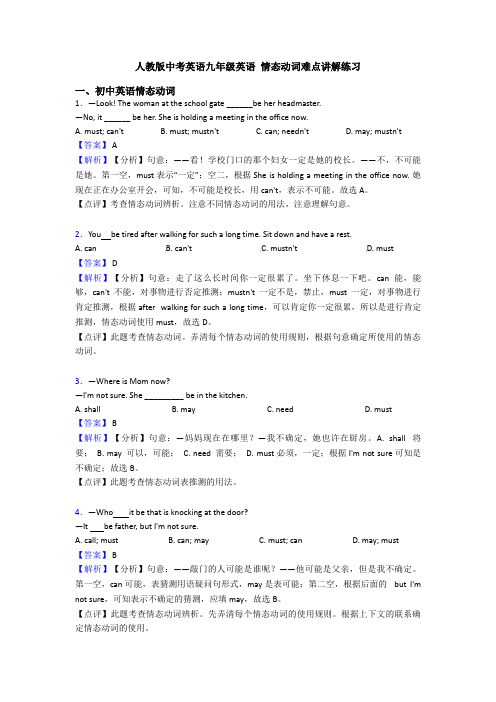
人教版中考英语九年级英语情态动词难点讲解练习一、初中英语情态动词1.—Look! The woman at the school gate ______be her headmaster.—No, it ______ be her. She is holding a meeting in the office now.A. must; can'tB. must; mustn'tC. can; needn'tD. may; mustn't【答案】 A【解析】【分析】句意:——看!学校门口的那个妇女一定是她的校长。
——不,不可能是她。
第一空,must表示“一定”;空二,根据She is holding a meeting in the office now. 她现在正在办公室开会,可知,不可能是校长,用can't,表示不可能。
故选A。
【点评】考查情态动词辨析。
注意不同情态动词的用法,注意理解句意。
2.You be tired after walking for such a long time. Sit down and have a rest.A. canB. can'tC. mustn'tD. must【答案】 D【解析】【分析】句意:走了这么长时间你一定很累了。
坐下休息一下吧。
can能,能够,can't不能,对事物进行否定推测;mustn't一定不是,禁止,must一定,对事物进行肯定推测,根据after walking for such a long time,可以肯定你一定很累,所以是进行肯定推测,情态动词使用must,故选D。
【点评】此题考查情态动词。
弄清每个情态动词的使用规则,根据句意确定所使用的情态动词。
3.—Where is Mom now?—I'm not sure. She _________ be in the kitchen.A. shallB. mayC. needD. must【答案】 B【解析】【分析】句意:—妈妈现在在哪里?—我不确定,她也许在厨房。
初三中考英语情态动词试题整理(有答案)

这篇关于初三中考英语情态动词试题整理(有答案),是⽆忧考特地为⼤家整理的,希望对⼤家有所帮助!【2012贵州铜仁】31.You ________ stop when the traffic light turns red.A. canB. had betterC. needD. must【答案】D【解析】本题考查情态动词的辨析。
句意为:当交通灯变红,你“必须”停下来。
根据语境可知此空意为“必须”,四个选项中,只有must具体有此意,故选D【2012贵州毕节】30. When winter comes, days get ______.A. long and longB. short and shortC. longer and longerD. shorter and shorter【答案】D 考查形容词⽐较级的⽤法。
句意为“冬天来了,天变得越来越短”,故选D。
【2012福建福州】41. — Mum, must I stay there the whole day?— No, you____________. You____________come back after lunch, if you like.A. mustn't; canB. needn't; mustC. needn't; may【答案】C【解析】选C。
考查情态动词的⽤法。
由must引导的⼀般疑问句表⽰否定回答时需要⽤needn’t或don’t have to;表⽰答应准许某⼈时情态动词可以⽤can或may。
故选C。
【2012贵州贵阳】45. “Whose notebook is this?” “It _______ Jim’s. It has his name on it.”A. can’t beB. must beC. can be【答案】B考查情态动词的⽤法。
表⽰猜测。
can’t be 意为“不可能是”;must be 意为“⼀定是”;can be 表⽰猜测,⼀般⽤于否定句或疑问句中,不⽤于肯定句中。
- 1、下载文档前请自行甄别文档内容的完整性,平台不提供额外的编辑、内容补充、找答案等附加服务。
- 2、"仅部分预览"的文档,不可在线预览部分如存在完整性等问题,可反馈申请退款(可完整预览的文档不适用该条件!)。
- 3、如文档侵犯您的权益,请联系客服反馈,我们会尽快为您处理(人工客服工作时间:9:00-18:30)。
4. maybe & may be maybe用于句首表示“可能;也许”,相当于perhaps; may be中may是情态动词,后接动词原形be,表示“可 能是”,在句中作谓语。两者可互换。 Maybe the boy is from Canada. = The boy may be from Canada. 那个男孩可能来自加拿大。
3. can & be able to (1)表示某种能力时,二者可通用; (2)can只用于现在时和过去时(could), be able to可用于各种 时态; (3)遇有助动词或情态动词时只能用be able to。 ①Jack could (was able to) swim at the age of five. 杰克在五岁时就能游泳了。 ②We’ll be able to fly to the moon soon. 不久我们就能飞往月球了。
D. needn’t
考点二 易混情态动词
( )1. The magazine ______ be Lily’s, for we can find her name on the cover.
A. may
B. might
C. could
D. must
( )2.This dictionary ______ Tom’s. It has Ann’s name on it.
A. can’t; mucch
C. mustn’t; much too
D. mustn’t; too much
( )3.]— ______we clean the classroom at once?
—No, you ______. You ______ clean it after school.
考点一 情态动词的基本用法
一、定义
情态动词表示说话者的情感、态度和语气。它们本身有 一定的意义,但没有人称和数的变化,不能单独作谓语,须 和动词一起构成句子的谓语。表示否定时在情态动词后加not (must,have to除外),表示疑问时将情态动词提至主语前即 可。
二、常见情态动词用法
【注意】
A. might be
B. may be
(1)情态动词过去式表示比原形更委婉的语气。 (2)mustn’t表示否定意义“禁止,不允许”。 (3)have to有人称、数和时态的变化,表示受客观条件限制, 意为“不得不”。例如: She has to take the bus to work. 她不得不坐公交车去上班。
(4)May. . . ? 句式的否定回答:No, . . . mustn’t/ can’t. Must. . . ? 句式的否定回答:No, . . . needn’t. (5)must; should; may; might都可以表示“可以”,可能性 程度为:must﹥should﹥may﹥might。
考点一 情态动词的基本用法
( )1.— ______ I borrow your history book?
—Sure. Here you are.
A. Must
B. May
C. Need
D. Will
( )2. —Whose T-shirt is this?
—It ______ be John’ s. It ’s ______ small for him.
A. must be true
B. can’t be true
C. may not be true
( )5.It doesn’t look like rain, so you ______ bring your umbrella with you.
A. shouldn’t
B. mustn’t
C. can’t
——那个穿红衣服的女孩一定是珍妮。她经常穿着红色的裙 子上学。
——不,一定不是珍妮。刚才我在图书馆看见她了,她还在 那儿看报纸呢。
2. have to & must
(1)have to主要表示客观需要,意为“不得不”。有人称和时 态的变化(has to; had to; will have to);
A. Must; needn’t; may
B. Must; mustn’t; can
C. Shall; can’t; must
D. Need; mustn’t; may
( )4. —The lake is said to be dry. Is that true?
—It ______ . Look, some kids are swimming in it.
考点二 易混情态动词
1. must & can’t 两者都表示推测,can’t意为“不可能”;must意为“一定”; 句中一般会有说明推测理由的附属从句。
―The girl in red must be Jenny. She often wears a red skirt to school. ―No, it can’t be Jenny. I met her in the library just now and she was still reading newspapers there.
(2)must强调说话人的主观看法,意为“必须;应该”;
(3)否定形式的不同:must的否定形式是mustn’t,表示“禁 止;不应该”;have to的否定形式是not have to,表示“不 必”,相当于needn’t。
①The boy had to stay at home alone because his parents both went to work. 那个男孩不得不独自呆在家里,因为他的父母都去上班了。 ②We must go to school on time. 我们必须按时上学。 ③You don’t have to (needn’t) lend me your car because young people mustn’t drive. 你不应该借给我你的车,因为年轻人不能开车。
